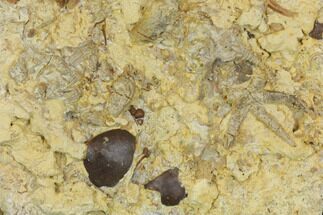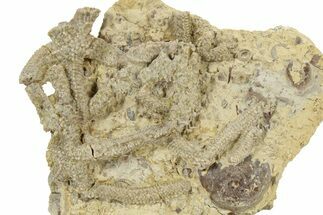This Specimen has been sold.
Abatocrinus (Crinoid) & Evactinopora (Bryozoan) - Missouri
This is a cool plate of Mississipian aged fossils from Missouri. There is a calynx of the crinoid Abatocrinus lepidus and a Bryozoan Evactinopora sp along with a multitude of other echinoderm fragments.
Evactinopora is very unique type of free-living bryozoan colony which formed a star-shaped skeleton. The star shape is defined by the rays which radiate from a central core. The colony has a many-sided star-shaped form with the number of rays varying from four to nine. The rounded base of the star rests on the sea floor and the rays of the star radiate upwards. The individual bryozoan animals which built the colony are called zooids and are found on the faces of the rays or blades.
Crinoids, sometimes commonly referred to as sea lilies, are animals, not plants. They are echinoderms related to starfish, sea urchins, and brittle stars. Many crinoid traits are like other members of their phylum; such traits include tube feet, radial symmetry, a water vascular system, and appendages in multiples of five (pentameral). They first appeared in the Ordovician (488 million years ago) and some species are still alive today.
Evactinopora is very unique type of free-living bryozoan colony which formed a star-shaped skeleton. The star shape is defined by the rays which radiate from a central core. The colony has a many-sided star-shaped form with the number of rays varying from four to nine. The rounded base of the star rests on the sea floor and the rays of the star radiate upwards. The individual bryozoan animals which built the colony are called zooids and are found on the faces of the rays or blades.
SPECIES
Abatocrinus lepidus & Evactinapora sp.
AGE
LOCATION
Marion County, Missouri
FORMATION
Burlington Formation
SIZE
Matrix 3.7x2.3"
CATEGORY
ITEM
#44139
We guarantee the authenticity of all of our specimens.
 Reviews
Reviews












